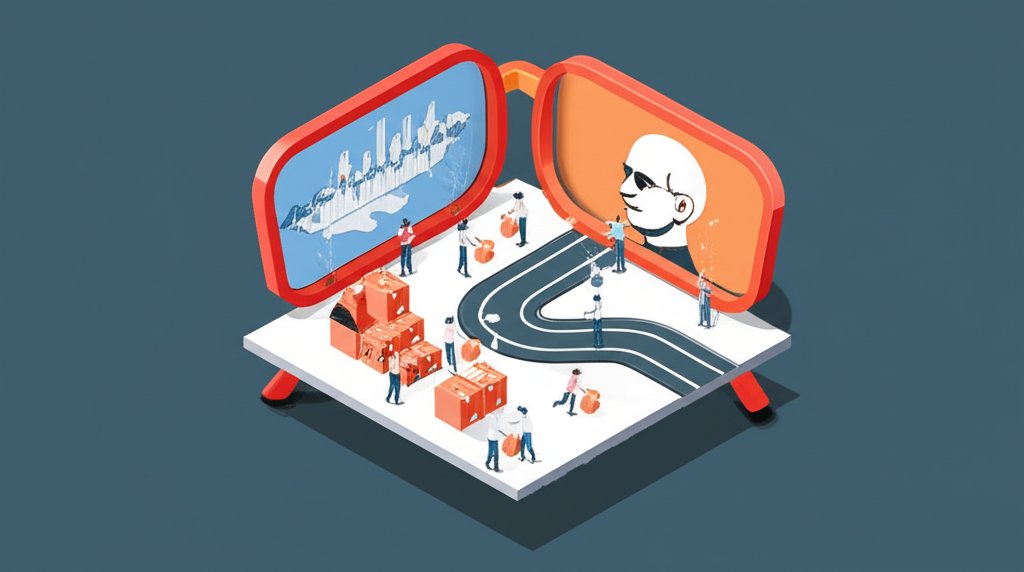Untuk gambaran yang lebih besar dan konteks penuh, pastikan Anda membaca panduan utama kami tentang Jeff Bezos Biography: How He Built Amazons Empire.
Jeff Bezos’s success with Amazon isn’t just about algorithms and logistics; it’s fundamentally rooted in his leadership style—a potent mix of customer obsession, calculated risk-taking, and an unwavering commitment to the long-term vision. So, how can you adapt these principles to your own leadership journey?
At a glance:
- Understand the “Day 1” Mentality: Embrace continuous innovation and resist complacency, regardless of your organization’s size or history.
- Prioritize Customer Obsession: Go beyond simply satisfying customers; actively anticipate and fulfill their unmet needs.
- Embrace Calculated Risks: Don’t shy away from bold experiments, but ensure they are well-reasoned and informed by data.
- Cultivate Long-Term Thinking: Make decisions that benefit your organization’s future, even if they require short-term sacrifices.
- Implement the Two-Pizza Rule: Structure teams for agility and efficiency, avoiding bloated processes and communication bottlenecks.
Customer Obsession: Beyond Satisfaction to Anticipation
Jeff Bezos leadership style places an unparalleled emphasis on customer obsession. This isn’t just about responding to complaints; it’s about deeply understanding customer needs and pain points—often before the customer even realizes them.
How to Implement Customer Obsession:
- Gather Direct Customer Feedback: Go beyond surveys. Bezos famously reads customer emails and highlights key concerns for his leadership team. Implement similar practices like actively participating in customer service interactions or hosting regular customer focus groups.
- Empathize with the Customer Journey: Map out every step a customer takes when interacting with your product or service. Identify friction points and opportunities for improvement.
- Act on Feedback Rapidly: Customer feedback is useless if it doesn’t translate into action. Implement a closed-loop system where feedback is tracked, prioritized, and addressed.
- Focus on Customer Lifetime Value: Recognize that a customer’s value extends far beyond a single transaction. Prioritize building long-term relationships through exceptional service and personalized experiences.
Example: Amazon’s introduction of “one-click ordering” stemmed directly from Bezos’s belief that reducing friction in the purchasing process would significantly enhance the customer experience, boosting sales and loyalty.
Embracing Risk: The “Fail Fast, Fail Cheap” Philosophy
Another hallmark of Jeff Bezos leadership style is the willingness to embrace risk and experiment with new ideas. Amazon has had its share of failures, but Bezos views these as learning opportunities, essential for driving innovation.
Cultivating a Culture of Calculated Risk-Taking:
- Encourage Experimentation: Create an environment where employees feel safe to propose and test new ideas, even if they might fail.
- Set Clear Expectations: Define the goals and metrics for each experiment upfront. This allows you to objectively evaluate its success or failure.
- Prioritize Data-Driven Decision-Making: Use data to inform your decisions about which risks to take and how to mitigate potential downsides.
- “Fail Fast, Fail Cheap”: Design experiments that allow you to quickly and inexpensively validate or invalidate hypotheses. This minimizes the potential impact of failure.
- Learn from Failures: Conduct thorough post-mortems of failed experiments to identify key learnings and prevent similar mistakes in the future.
Case Snippet: Amazon’s Fire Phone was a notable failure, costing the company an estimated $170 million. However, Bezos viewed it as a valuable learning experience, providing insights that informed the development of future products and services.
Long-Term Vision: Playing the Infinite Game
Jeff Bezos is known for his relentless focus on the long term. He prioritizes investments that may not yield immediate returns but are crucial for Amazon’s future growth and success. Learn about Bezos’s journey and how this philosophy was foundational to his success.
Adopting a Long-Term Perspective:
- Develop a Clear Vision: Articulate a compelling vision for your organization’s future that extends beyond short-term goals.
- Prioritize Long-Term Investments: Allocate resources to projects and initiatives that will create sustainable competitive advantages, even if they require short-term sacrifices.
- Resist Short-Term Pressures: Don’t let quarterly earnings reports or market fluctuations distract you from your long-term vision.
- Measure Long-Term Impact: Develop metrics that track the long-term impact of your decisions and investments.
- Communicate Consistently: Regularly communicate your long-term vision to employees, customers, and stakeholders to ensure everyone is aligned.
Concrete Example: Amazon’s investment in Amazon Web Services (AWS) in the early 2000s was initially met with skepticism. However, Bezos believed that cloud computing was the future, and he was willing to invest heavily in building what is now a dominant force in the industry.
The “Day 1” Mentality: Avoiding Complacency
Bezos famously says Amazon operates as if it’s always “Day 1.” This means constantly innovating, experimenting, and avoiding the complacency that can creep in as organizations mature.
Maintaining a “Day 1” Culture:
- Embrace Disruption: Encourage employees to challenge the status quo and look for ways to disrupt existing processes and business models.
- Stay Agile: Maintain a flexible and adaptable organizational structure that allows you to respond quickly to changing market conditions.
- Empower Employees: Give employees the autonomy to make decisions and take ownership of their work.
- Celebrate Innovation: Recognize and reward employees who come up with innovative ideas and solutions.
- Continuously Learn: Encourage employees to continuously learn and develop new skills. Amazon’s focus on written narratives encourages deep thoughtfulness and learning.
The “Two-Pizza Rule”: Team Structure and Communication
Bezos’s “two-pizza rule” dictates that teams should be small enough that they can be fed with two pizzas. This promotes agility, collaboration, and efficient communication.
Applying the Two-Pizza Rule:
- Limit Team Size: Keep teams small and focused, typically no more than 6-10 people.
- Empower Teams: Give teams the autonomy to make decisions and own their results.
- Promote Collaboration: Foster a culture of open communication and collaboration within and between teams.
- Avoid Silos: Break down organizational silos and encourage cross-functional collaboration.
- Use Technology Effectively: Leverage technology to facilitate communication and collaboration. This includes things like shared documents, instant messaging, and video conferencing.
Practical Playbook: Implementing Bezos’s Leadership Style
- Start Small: Don’t try to implement all of Bezos’s leadership principles at once. Start with one or two that resonate most with you and your organization.
- Lead by Example: Demonstrate these principles in your own behavior. If you want your employees to be customer-obsessed, show them that you are too.
- Provide Training: Offer training and coaching to help employees develop the skills and mindset needed to embrace these principles.
- Measure Progress: Track your progress in implementing these principles and make adjustments as needed.
- Be Patient: It takes time to build a culture of customer obsession, risk-taking, and long-term thinking. Be patient and persistent, and you will eventually see results.
Quick Answers: Common Questions and Misconceptions
Q: Is Bezos’s leadership style only applicable to large companies?
A: No. While Amazon is a massive organization, the principles of customer obsession, risk-taking, and long-term thinking are applicable to companies of all sizes. Smaller organizations may even find it easier to implement these principles due to their inherent agility.
Q: Isn’t Bezos’s leadership style too demanding?
A: Bezos’s leadership style can be demanding, but it’s also highly rewarding for those who thrive in a fast-paced, innovative environment. It’s important to find a balance between pushing employees to achieve their potential and creating a supportive and inclusive work environment.
Q: How can I balance customer obsession with profitability?
A: Customer obsession shouldn’t come at the expense of profitability. The goal is to find ways to deliver exceptional value to customers while also generating sustainable profits. This requires a deep understanding of your business model and a willingness to experiment with new approaches.
Actionable Close
The “Jeff Bezos leadership style” emphasizes action, but informed, strategic action. Adopt a “Day 1” mindset, and commit to continuous improvement. Start with a customer feedback initiative, pilot a small risk-taking project, or refine your long-term vision. The key is to start somewhere and build momentum.











